by bria4123 on March 2, 2013
Chiang Mai’s Wat Phra Singh has some of the best examples of northern Thai architecture, so it was high on my list of places to see during my return trip to northern Thailand last year.

Wat Phra Singh has one of the finest ho trais (building for storing scriptures) in Thailand. It’s one of the best places to begin exploring, and falling in love with, northern Thai art. [click to continue…]
by bria4123 on February 28, 2013
Chiang Mai was the capital of the Lan Na Kingdom before Siam incorporated it at the end of the 19th century. Lan Na created one of Southeast Asia’s greatest artistic heritages after Chiang Mai’s founding in 1296. More than 100 chronicles of Lan Na’s political history were written and stored in monasteries–this culture valued literature.
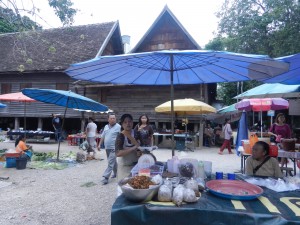
Most cultures’ political chronicles are usually serious because they’re supposed to legitimize the current dynasty, but Chiang Mai chronicles have Thai traits that make this part of the world very appealing. [click to continue…]
by bria4123 on February 21, 2013
Most archeologists and linguists believe that Thais originated in southern China. As their populations rose and as the Qin and Han Dynasties expanded into the Yangtze area, Thai groups spread out from Vietnam to northeastern India. So Thai cultures became very widespread.

There are still Thai-speaking groups in many countries outside Thailand. But this great culture isn’t usually taught in schools. One of the reasons is it’s hard to get a handle on. Its people thought in different ways than they have in better known civilizations like China and India. But Thai cultures encompasses such a wide area, are very rich, and still thrive. So we’ll venture into their ancient roots. [click to continue…]
by bria4123 on February 17, 2013
There are several reasons for studying the ancient Lao kingdom of Lan Xang.
1. It was one of the main states that emerged after Khmer Empire began to contract in the 13th century, and it thrived for many centuries alongside the ones that developed in Thailand.
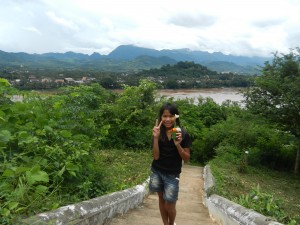
2. Lan Xang was part of a big international trading network. Luang Prabang was its capital (across the Mekong in the above shot), and it grew between the great northern Thai kingdom of Lan Na (based in modern Chiang Mai) and Yunnanese cultures around Lijiang. So Lan Xang was a major cultural crossroads for societies all over mainland Southeast Asia.
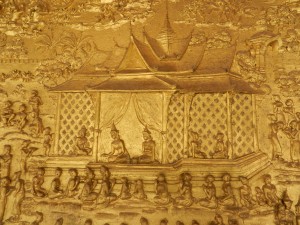
3. The natural scenery and art around Luang Prabang are so beautiful that most people who go there never forget them.
So we’ll take a brief look at how this kingdom emerged. [click to continue…]
by bria4123 on February 13, 2013
I’ve written a lot of posts in this website about the beauty of Thai art–I’ve found it utterly enchanting, and I hope you get addicted if you read enough of my posts about it. But some Thai art has a dark side.
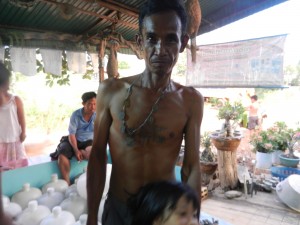
This man in the countryside around Sukhothai follows an ancient Thai tradition of wearing tattoos and amulets to protect himself from harm. Why would someone be so nervous in surroundings that I had found so charming? [click to continue…]
by bria4123 on February 10, 2013
If you venture in any direction around Sukhothai’s center, you’ll be surrounded by enchantments.
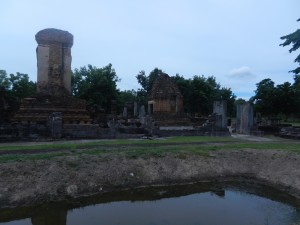
The temples I found in all four made Sukhothai one of the most beautiful places I’ve seen. We’ll explore a couple on the south side in this post. [click to continue…]
by bria4123 on February 6, 2013
Sukhothai’s graceful architecture spreads from its central ritual center and ripples through the surrounding area.
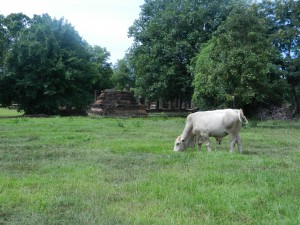
All life forms and Thailand’s gentle art forms blend into an expression of the Buddha’s compassion, and a perspective of the world that’s characteristically Thai. [click to continue…]
by bria4123 on February 4, 2013
No single building in Sukhothai’s ritual center makes many people say “WOW!” But all the buildings together left impressions on me that I’ll always treasure, and they comprise one of Thai art’s most influential works.
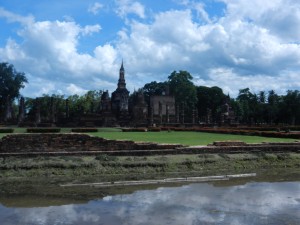
They also make up a great perspective of the world, which is characteristically Thai, and a great contrast with Western ways of seeing. [click to continue…]
by bria4123 on January 29, 2013
Angkor Wat commands, but Sukhothai floats. Its central shrine, Wat Mahathat, isn’t big enough to dominate the perspective as you walk around the area.
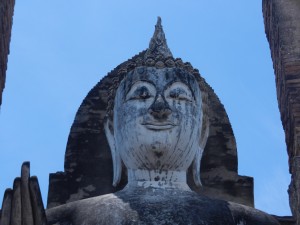
More than 150 other shrines spread around the center, so as you walk around Wat Mahathat, the perspective expands through a landscape full of enchantments. [click to continue…]
by bria4123 on January 25, 2013
Many Thais still see Sukhothai’s ritual center as a model of how society and the world are held together.

Lots of people admire Thai art for its graceful forms. Like Angkor Wat, Sukhothai’s Wat Mahathat’s has a system of a central spire and towers that surround it. Some scholars think they symbolize Mt Meru and the peaks that surround it in Indian mythology. But Sukhothai turned this Indian and Khmer schema into a work of Thai art. I found that the longer you linger there, the more enchanting it becomes. [click to continue…]











